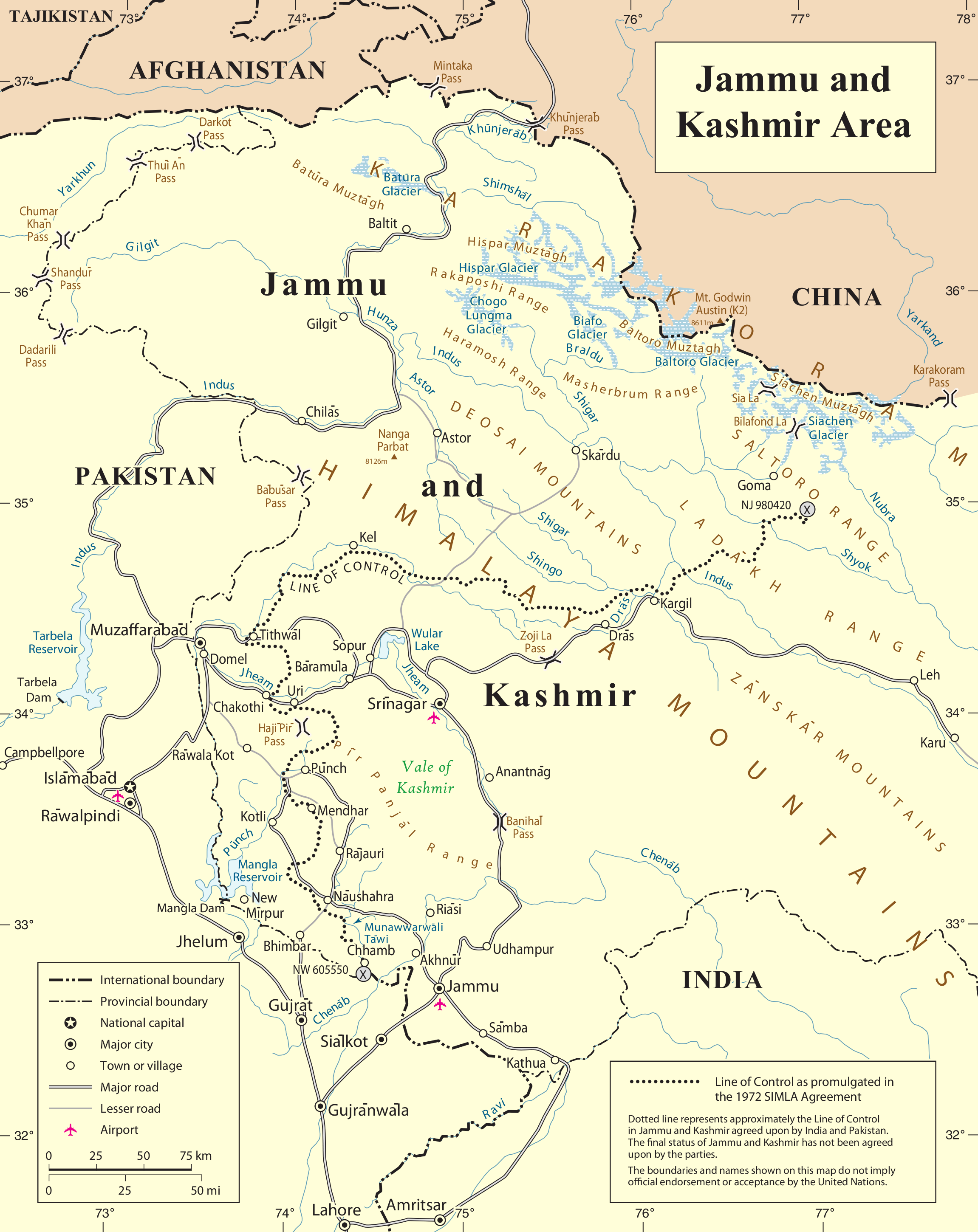|
Kashmir Separatist Movement
The Kashmir conflict is a territorial conflict over the Kashmir region, primarily between India and Pakistan, and also between China and India in the northeastern portion of the region. The conflict started after the partition of India in 1947 as both India and Pakistan claimed the entirety of the former princely state of Jammu and Kashmir (princely state), Jammu and Kashmir. It is a dispute over the region that escalated into three wars between India and Pakistan and several other armed skirmishes. India controls approximately 55% of the land area of the region that includes Jammu Division, Jammu, the Kashmir Valley, most of Ladakh, the Siachen Glacier, and 70% of its population; Pakistan controls approximately 30% of the land area that includes Azad Kashmir and Gilgit-Baltistan; and China controls the remaining 15% of the land area that includes the Aksai Chin region, the mostly uninhabited Trans-Karakoram Tract, and part of the Demchok sector. After the partition of India ... [...More Info...] [...Related Items...] OR: [Wikipedia] [Google] [Baidu] |
Kashmir Map
Kashmir ( or ) is the Northwestern Indian subcontinent, northernmost geographical region of the Indian subcontinent. Until the mid-19th century, the term ''Kashmir'' denoted only the Kashmir Valley between the Great Himalayas and the Pir Panjal Range. The term has since also come to encompass a larger area that includes the Indian-administered territories of Jammu and Kashmir (union territory), Jammu and Kashmir and Ladakh, the Pakistani-administered territories of Azad Kashmir and Gilgit-Baltistan, and the Chinese-administered territories of Aksai Chin and the Trans-Karakoram Tract. Quote: "Kashmir, region of the northwestern Indian subcontinent. It is bounded by the Uygur Autonomous Region of Xinjiang to the northeast and the Tibet Autonomous Region to the east (both parts of China), by the Indian states of Himachal Pradesh and Punjab to the south, by Pakistan to the west, and by Afghanistan to the northwest. The northern and western portions are administered by Pakistan a ... [...More Info...] [...Related Items...] OR: [Wikipedia] [Google] [Baidu] |
European Foundation For South Asian Studies (EFSAS)
The European Foundation for South Asian Studies (EFSAS) is an independent think tank and policy research institute on South Asia. The institute is located in Amsterdam, the Netherlands. According to its website, the fundamental research of the institute concentrates on conflict resolution, India–Pakistan relations, Kashmir conflict, religious terrorism, radicalisation and extremism emanating from the region of South Asia. EFSAS also has a membership at the Civil Society Empowerment Programme. Accordingly, it is part of a consortium of various civil society organisations committed to campaigning against radicalisation and violent extremism established by the Civil Society Empowerment Programme, which is coordinated by the Radicalisation Awareness Network and funded by the European Commission’s Directorate-General for Migration and Home Affairs. Activities The institute’s activities consist of publishing study papers, articles, commentaries and organizing conferences and ... [...More Info...] [...Related Items...] OR: [Wikipedia] [Google] [Baidu] |
Simla Agreement
The Simla Agreement, also spelled Shimla Agreement, was a peace treaty signed between India and Pakistan on 2 July 1972 in Shimla, the capital of Himachal Pradesh. It followed the Indo-Pakistani War of 1971, which began after India intervened in East Pakistan as an ally of Mukti Bahini who were fighting against Pakistani state forces in the Bangladesh Liberation War. The treaty's official purpose was stated to serve as a way for both countries to "put an end to the conflict and confrontation that have hitherto marred their relations" and to conceive the steps to be taken for further normalization of India–Pakistan relations while also laying down the principles that should govern their future interactions. The treaty gave back more than 13,000 km2 of land that the Indian Army had seized in Pakistan during the war, though India retained a few strategic areas, including Turtuk, Dhothang, Tyakshi (earlier called Tiaqsi) and Chalunka of Chorbat Valley, which w ... [...More Info...] [...Related Items...] OR: [Wikipedia] [Google] [Baidu] |
Harvard University Press
Harvard University Press (HUP) is an academic publishing house established on January 13, 1913, as a division of Harvard University. It is a member of the Association of University Presses. Its director since 2017 is George Andreou. The press maintains offices in Cambridge, Massachusetts, near Harvard Square, and in London, England. The press co-founded the distributor TriLiteral LLC with MIT Press and Yale University Press. TriLiteral was sold to LSC Communications in 2018. Notable authors published by HUP include Eudora Welty, Walter Benjamin, E. O. Wilson, John Rawls, Emily Dickinson, Stephen Jay Gould, Helen Vendler, Carol Gilligan, Amartya Sen, David Blight, Martha Nussbaum, and Thomas Piketty. The Display Room in Harvard Square, dedicated to selling HUP publications, closed on June 17, 2009. Related publishers, imprints, and series HUP owns the Belknap Press imprint (trade name), imprint, which it inaugurated in May 1954 with the publication of the ''Harvard Guide to ... [...More Info...] [...Related Items...] OR: [Wikipedia] [Google] [Baidu] |
Sino-Indian Border Dispute
The Sino–Indian border dispute is an ongoing territorial dispute over the sovereignty of two relatively large, and several smaller, separated pieces of territory between China and India. The territorial disputes between the two countries stem from the legacy of British colonial-era border agreements, particularly the McMahon Line in the eastern sector, which was drawn in 1914 during the Simla Convention between British India and Tibet but was never accepted by China. In the western sector, the dispute involves Aksai Chin, a region historically linked to the princely state of Jammu and Kashmir but effectively controlled by China after the 1962 war. The lack of mutually recognized boundary agreements has led to ongoing tensions and occasional military clashes. The first of the territories, Aksai Chin, is administered by China and claimed by India; it is mostly uninhabited high-altitude wasteland but with some significant pasture lands at the margins. It lies at the intersec ... [...More Info...] [...Related Items...] OR: [Wikipedia] [Google] [Baidu] |
Sino-Indian War
The Sino–Indian War, also known as the China–India War or the Indo–China War, was an armed conflict between China and India that took place from October to November 1962. It was a military escalation of the Sino–Indian border dispute. Fighting occurred along India's border with China, in India's North-East Frontier Agency east of Bhutan, and in Aksai Chin west of Nepal. There had been a series of border skirmishes between the two countries after the 1959 Tibetan uprising, when India granted asylum to the Dalai Lama. Chinese military action grew increasingly aggressive after India rejected proposed Chinese diplomatic settlements throughout 1960–1962, with China resuming previously banned "forward patrols" in Ladakh after 30 April 1962. Amidst the Cuban Missile Crisis, seeing that the U.S. was pre-occupied with dealing with it, China abandoned all attempts towards a peaceful resolution on 20 October 1962,''Webster's Encyclopedic Unabridged Dictionary of the English ... [...More Info...] [...Related Items...] OR: [Wikipedia] [Google] [Baidu] |
Line Of Control
The Line of Control (LoC) is a military control line between the Indian and Pakistanicontrolled parts of the former princely state of Jammu and Kashmir—a line which does not constitute a legally recognized international boundary, but serves as the '' de facto'' border. It was established as part of the Simla Agreement at the end of the Indo-Pakistani War of 1971. Both nations agreed to rename the ceasefire line as the "Line of Control" and pledged to respect it without prejudice to their respective positions. Apart from minor details, the line is roughly the same as the original 1949 cease-fire line. The part of the former princely state under Indian control is divided into the union territories of Jammu and Kashmir and Ladakh. The Pakistani-controlled section is divided into Azad Kashmir and Gilgit–Baltistan. The northernmost point of the Line of Control is known as NJ9842, beyond which lies the Siachen Glacier, which became a bone of contention in 1984. To the ... [...More Info...] [...Related Items...] OR: [Wikipedia] [Google] [Baidu] |
UN Mediation Of The Kashmir Dispute
The United Nations has played an advisory role in maintaining peace and order in the Kashmir region soon after the independence and partition of British India into the dominions of Pakistan and India in 1947, when a dispute erupted between the two new States on the question of accession over the princely state of Jammu and Kashmir. India took this matter to the UN Security Council, which passed resolution 39 (1948) and established the United Nations Commission for India and Pakistan (UNCIP) to investigate the issues and mediate between the two new countries. Following the cease-fire of hostilities, it also established the United Nations Military Observer Group in India and Pakistan (UNMOGIP) to monitor the cease-fire line. Overview 1948–1951 Following the outbreak of the Indo-Pakistani War of 1947, India's Governor General Mountbatten flew to Lahore on 1 November 1947 for a conference with Muhammad Ali Jinnah, proposing that, in all the princely States where the rul ... [...More Info...] [...Related Items...] OR: [Wikipedia] [Google] [Baidu] |






